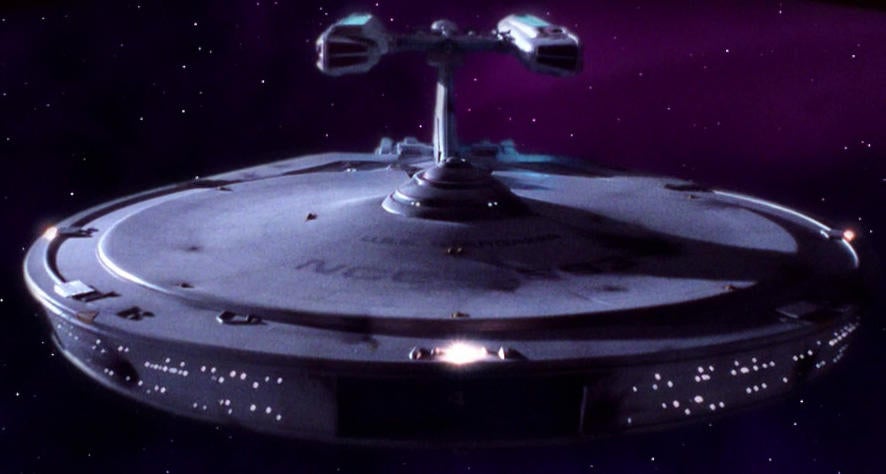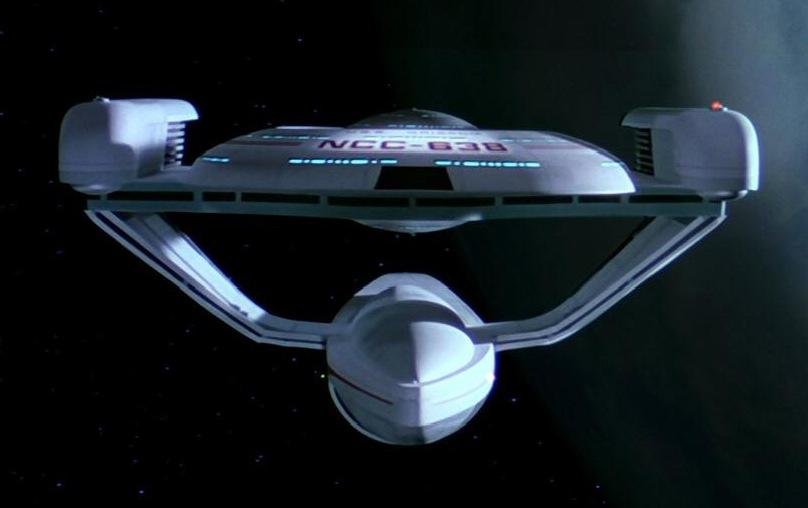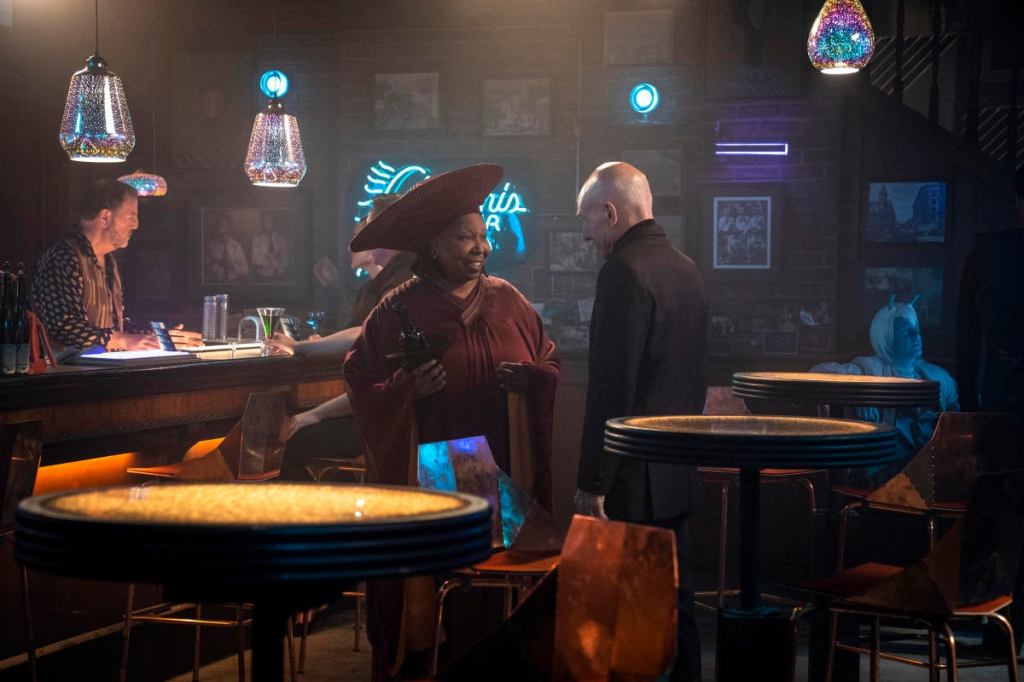Jean-Luc Picard is back in action today in the first episode of Star Trek: Picard‘s second season. [SPOILERS spoilers for the new episode follow.] In “The Star Gazer,” Picard is getting on with his new lease on life after the events of Star Trek: Picard‘s first season. He’s faced with a romantic opportunity that he can’t seem to grapple with, catches up with an old friend, and returns to the stars when an old foe requests his presence by name. Then, when he believes he is about to die, he’s transported to an alternate timeline where history went a little differently.
Videos by ComicBook.com
This episode is full of exciting Easter eggs and references to Star Trek history, especially Jean-Luc Picard’s decades-spanning story. We’ve collected some of the biggest ones hers. Keep reading to see the significant Easter eggs and references in the first episode of Star Trek: Picard‘s second season, “The Star Gazer.”
Star Trek: Picard‘s second season premiere is streaming now on Paramount+, along with the show’s entire first season and every episode of Star Trek ever. New episode of Star Trek: Picard will debut weekly on Thursdays on Paramount +.
The First Fully Romulan Starfleet Cadet

During his speech at Starfleet Academy, Picard recognizes Elnor as the first “fully Romulan” cadet in Starfleet Academy. Elnor receives a round of applause.
Picard specifically saying “fully Romulan” implies that Starfleet Academy has previously hosted cadets of mixed Romulan lineage. One such cadet could be Simon Tarses, a half-Human/half-Romulan Starfleet officer who served aboard the USS Enterprise-D. Tarses had claimed he was half-Vulcan on his Starfleet entrance application, fearing that his Romulan background would reflect poorly on him. The truth came out during the witch hunt of a trial in the Star Trek: The Next Generation episode “The Drumhead.”
Saavik, who appears in the “Genesis trilogy” of Star Trek movies, had been written as a half-Vulcan/half-Romulan Starfleet officer. While secondary fiction and the films’ ancillary materials support this, any explicit reference to her Romulan lineage was cut from the movie and never stated on-screen. Thus, canonically, she is assumed to be fully Vulcan.
The Stargazer

The episode reveals that Chris Rio has rejoined Starfleet and is now in command of the USS Stargazer. He uses the line “make it so” to deliver his order, also Picard’s signature command, prompting Dr. Jurati to comment on the “pressure of legacy.”
Picard’s first command was another ship called the USS Stargazer, as he explains to Seven when he comes aboard. In reality, it’s an entirely different ship, but then again, so too was the USS Enterprise-D and an altogether different vessel from Kirk’s Enterprise. The name carries weight.
Hikaru Sulu

As the cadets receive their boarding assignments, one of the listed ships bears Hikaru Sulu’s name. George Takei played Sulu in Star Trek: The Original Series and its six subsequent movies and an episode of Star Trek: Voyager.
Sulu served under Captain Kirk aboard the USS Enterprise and USS Enterprise-A. Later, he took command of the USS Excelsior.
USS Grissom

Another ship named during the assignment scene is the USS Grissom. At least two previous Starfleet vessels have had this name.
The earlier of the two surveyed the Genesis planet in Star Trek III: The Search for Spock. The ship was destroyed by Kruge’s Bird-of-Prey, though Kruge only wanted to disable the vessel to take prisoners. Kruge then executed the gunner responsible for the “lucky shot.”
Another USS Grissom was active during the Star Trek: The Next Generation, as mentioned in the episode “The Most Toys.” The ship was destroyed during the Dominion War, as confirmed by the Star Trek: Deep Space Nine episode “Field of Fire.”
Kobayashi Maru

In his new position as Starfleet Academy’s chancellor, Picard mentions that he plans to redesign the Kobayashi Maru test. Raffi says that she always hated that test.
The Kobayashi Maru is the famously frustrating Starfleet Academy test that teaches cadets what it feels like to be in a no-win scenario. As revealed in Star Trek II: The Wrath of Khan, James T. Kirk famously cheated to defeat the test by reprogramming it to allow for a favorable outcome.
More recently, Dal R’El underwent a star-studded version of the Kobyashi Maru in the Star Trek: Prodigy episode titled “Kobayashi.” The 2009 Star Trek movie revealed that Spock created the Kobayashi Maru test in the alternative Kelvin timeline, getting his and Kirk’s relationship off to a contentious start.
The Many and the Few

After his speech, Picard catches up with Elnor and gifts him a copy of Spock’s memoir detailing his time as one of the earliest Vulcan cadets enrolled in Starfleet Academy. From Star Trek: Picard’s first season, we know that Elnor shares Picard’s appreciation for physical books.
Spock is, of course, the iconic first officer serving with Captian Kirk aboard the USS Enterprise in Star Trek: The Original Series. His journey trying to navigate his way as an outsider among a primarily human crew, and learning to balance the Human and Vulcan parts of his personality, would likely be invaluably insightful for Elnor.
The actual title of the book is The Many and the Few. This title refers to Spock’s famous quote that “the needs of the many outweigh the needs of the few,” which becomes a recurring theme of the Star Trek movies.
10 Forward

Picard visits the “10 Forward” bar. There he catches up with an old friend, Guinan.
Guinan’s relationship with Picard pre-dates his time commanding the Enterprise. He invited her aboard the ship to run the lounge, also called Ten Forward. Picard often confided in Guinan, someone he could trust outside of the Starfleet chain of command. Her advice often proved enlightening.
It may also be worth noting that she has an unusual reaction to fluctuations in the timeline, as seen in the episode “Yesterday’s Enterprise.” This trait may be relevant to this season of Picard, given that it involves time travel. She also has a history with Q that has thus far gone largely untold, which may also be relevant to this season of Picard.
The “hooch” she offers Picard at the bar is Saurian brandy. Created by the Saurians, the liquor has appeared throughout Star Trek history in various shows and movies.
Artificial Heart

Guinan makes a pointed comment about Picard’s heart. She references it being “artificial” or “synthetic.”
Picard did have an artificial heart, first revealed in the Next Generation episode “Samaritan Snare.” In the episode, Dr. Pulaski insists he has the artificial heart replaced, a procedure he’d been putting off. Later, the episode “Tapestry” showed how Picard ended up with an artificial heart in the first place. He was stabbed in the heart by a Nausicaan during a bar brawl while still an ensign.
However, Picard now has a synthetic heart, along with a synthetic body. It results from his consciousness transferring into Dr. Soong’s golem body in the final episode of Star Trek: Picard‘s first season.
The Borg Queen

Once aboard the Stargazer, Picard faces an old foe in the Borg. Picard’s history with the Borg goes back to The Next Generation episode “Q, Who?” Picard’s relationship with the Borg is truly defined in the two-part episode “The Best of Both Worlds,” when the Borg assimilates him into Locutus.
The Borg sends over their queen as an envoy. She begins assimilating the Stargazer, built with Borg tech acquired from the derelict Borg cube central to Picard‘s first season. The concept of the Borg queen first appeared in Star Trek: First Contact. Episodes of Star Trek: Voyager confirmed multiple queens exist.
Q

Finally, after the apparent destruction of the Stargazer, Picard wakes up back at home, but things have changed. Q is there to greet him.
In Star Trek: The Next Generation, Q was Picard’s first opponent, appearing in the two-part premiere episode “Encounter at Farpoint.” Q was also responsible for Picard’s first encounter with the Borg in “Q, Who?” He previously sent Picard to an alternate universe in the episode “Tapestry.” He returned for the two-part Next Generation finale, “All Good Things….”
Q’s “mon captiane” line is a callback to how he’d refer to Picard during The Next Generation. “The trial never ends” were his last words to Picard in “All Good Things…,” referencing the trial of humanity that Q began in “Encounter at Farpoint.”








